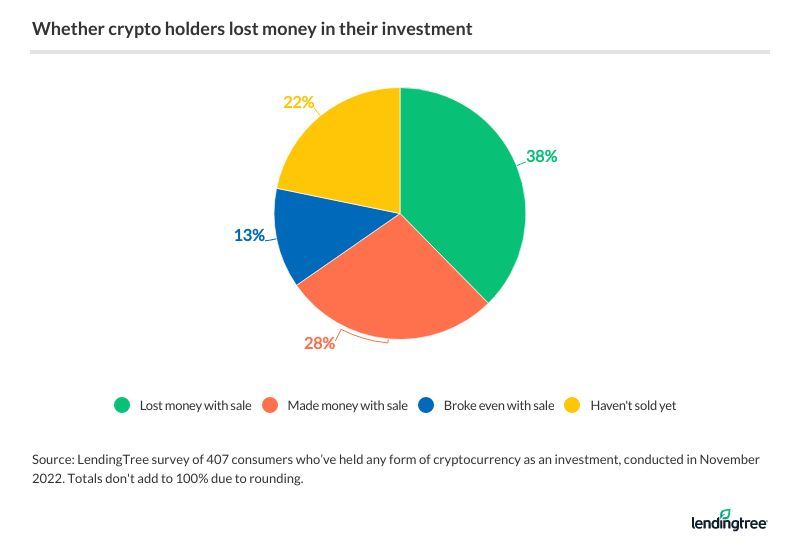Losses, regulations and finding a balance

The world of cryptocurrencies can be as alluring as it is terrifying, with stories of overnight fortunes capturing headlines and imaginations. Yet, as investors delve into this enigmatic realm, the lesser-discussed dangers become increasingly apparent. From large losses to complex legal issues, the crypto space presents unique challenges that require measured responses.
Join us as we embark on a journey to uncover the hidden struggles of crypto investors and examine the urgent need for thoughtful regulation to ensure a safe, innovative and thriving future for digital currencies.
The double-edged sword of crypto-investment
Cryptocurrencies have caught the world’s attention, showing economic promise freedom and lucrative opportunities. But beneath the surface lies a tumultuous realm, often full of loss and uncertainty.
Market volatility is inherent in the world of cryptocurrencies. Drastic price swings can eat away at investors’ fortunes overnight. Unpredictability, while exciting, often leads to impulsive decisions and missteps, which ultimately contribute to losses. The lack of comprehensive regulation further exacerbates the problem, leaving investors to navigate treacherous waters largely unaided.
For example, many investors who entered the market during the 2017 boom experienced significant losses when the bubble burst. Investors lured by stories of overnight millionaires faced financial ruin as the value of their investments plummeted.
Regulation: a beacon of stability?
Introducing well-designed regulatory frameworks can offer stability and security in the crypto space. Proper regulation deters fraudulent activities, provides investor leverage and lends credibility to cryptocurrencies as legitimate financial instruments. Regulation can build investor confidence by curbing widespread market manipulation and addressing issues such as money laundering, allowing for more cautious and informed decisions.
Countries such as the United States and the European Union have begun to recognize the need for regulation and have begun drafting guidelines to protect investors without stifling innovation. Although lately the US seems intent on exiling crypto to foreign shores.
The Fine Line: Nurturing innovation and protecting investors
Finding a balance between promoting innovation and safeguarding investor interests remains a challenge. Excessive regulation risks stifling creativity and hindering the growth of this nascent industry. Conversely, insufficient supervision can expose investors to unnecessary risk. The key lies in creating regulations that promote transparency and accountability without hindering the sector’s development.
Switzerland, for example, has become a hub for crypto innovation by adopting a pragmatic regulatory approach. Their policies focus on striking a balance between promoting growth and protecting investors, setting an example for other nations.
Loss and learning
Analyzing individual investors’ stories can provide valuable insight into the pitfalls and dangers of crypto investing. Common threads emerge, such as insufficient research, lack of diversification and overreliance on social media influencers. These cautionary tales serve as reminders of the importance of education and caution in navigating the volatile world of cryptocurrencies.
One such example is a man who invested his savings in a little-known coin after being influenced by social media hype. When the coin’s value fell, he lost everything, highlighting the dangers of following trends without due diligence.

Centralized Crypto Exchanges: A Regulatory Conundrum
The predominance of centralized exchanges poses a regulatory challenge. These platforms are vulnerable to hacks and are attractive targets for cybercriminals. Implementing robust security measures and holding exchanges accountable for breaches are important steps to reduce risk. Encouraging the development of decentralized exchanges could also provide a safer, more transparent option for crypto investors.
The infamous Mt. Gox hack serves as a stark reminder of the risks associated with centralized exchanges. In 2014, the platform lost 850,000 Bitcoins, worth approximately $450 million at the time, due to a security breach, which shook investor confidence and underscored the need for improved security measures.
Self-regulation: a viable solution?
As regulations continue to evolve, self-regulation is emerging as a potential temporary solution. By adopting best practices and following industry standards, crypto companies can demonstrate their commitment to investor protection. However, self-regulation is not a panacea; comprehensive, well-designed regulations are necessary to ensure long-term stability and growth.
A notable example of self-regulation is the creation of the Virtual Commodity Association (VCA) by several prominent US-based crypto exchanges. This consortium aims to promote transparency, promote cooperation and meet common regulatory challenges among its members.
Countries around the world are grappling with the challenge of regulating cryptocurrencies. While some, like China, take a strict stance, others embrace a more laissez-faire approach. By examining the successes and failures of various regulatory measures, policymakers can gain valuable insight into the development of balanced, effective frameworks that accommodate their unique contexts.
Japan, for example, has established a licensing system for crypto exchanges and implemented strict anti-money laundering measures. These efforts have helped legitimize the crypto market while offering investors a degree of protection.
Harmonization of innovation and safety
Addressing the hidden struggles of crypto investors requires a nuanced approach to regulation. The road ahead is full of challenges, but success lies in forging a path that maintains investor interests without stifling innovation. Ultimately, the future of digital currency depends on our ability to create a dynamic and secure environment in which both investors and the industry can flourish.
As the world of cryptocurrencies continues to evolve, it is critical to understand the challenges that investors face and address their concerns through appropriate regulation. By learning from past experiences and using a balanced approach, policymakers can foster a thriving crypto ecosystem that fosters innovation while safeguarding the interests of investors, regardless of their level of expertise.
Disclaimer
In accordance with Trust Project guidelines, this feature article presents the opinions and perspectives of industry experts or individuals. BeInCrypto is dedicated to transparent reporting, but the views expressed in this article do not necessarily reflect the views of BeInCrypto or its employees. Readers should verify information independently and consult with a professional before making decisions based on this content.
























